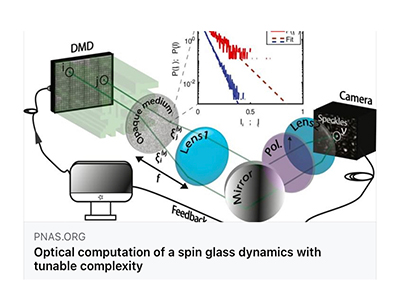Authors: Marco Leonetti, Erik Hörmann, Luca Leuzzi, Giorgio Parisi and Giancalro Ruocco
PNAS 118, e2015207118, Published 25 May 2021
DOI: https://www.pnas.org/content/118/21/e2015207118
Abstract: Spin glasses (SGs) are paradigmatic models for physical, computer science, biological, and social systems. The problem of studying the dynamics for SG models is nondetermistic polynomial-time (NP) hard; that is, no algorithm solves it in polynomial time. Here we implement the optical simulation of an SG, exploiting the N segments of a wavefront-shaping device to play the role of the spin variables, combining the interference downstream of a scattering material to implement the random couplings between the spins (the Jij matrix) and measuring the light intensity on a number P of targets to retrieve the energy of the system. By implementing a plain Metropolis algorithm, we are able to simulate the spin model dynamics, while the degree of complexity of the potential energy landscape and the region of phase diagram explored are user defined, acting on the ratio P/N=α. We study experimentally, numerically, and analytically this Hopfield-like system displaying a paramagnetic, ferromagnetic, and SG phase, and we demonstrate that the transition temperature Tg to the glassy phase from the paramagnetic phase grows with α. We demonstrate the computational advantage of the optical SG where interaction terms are realized simultaneously when the independent light rays interfere on the detector’s surface. This inherently parallel measurement of the energy provides a speedup with respect to purely in silico simulations scaling with N.

